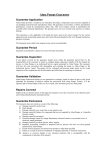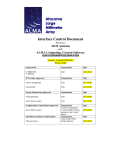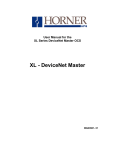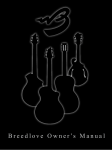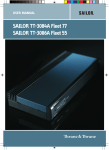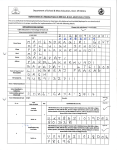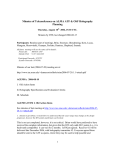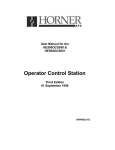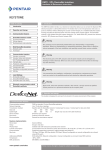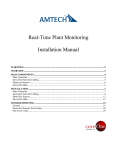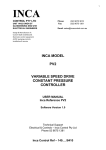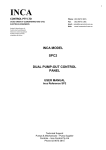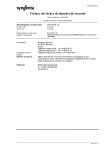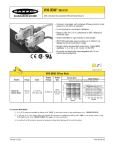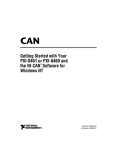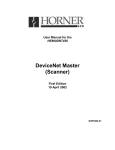Download ALMA Monitor and Control Bus Interface Specification 2001
Transcript
ALMA Monitor and Control Bus Interface Specification ALMA-70.35.10.03-001-A-SPE Version: A Status: (Draft, Pending, Approved, Released, or Obsolete) 2001-09-07 Prepared By: Name(s) and Signature(s) Mick Brooks Larry D’Addario Organization NRAO NRAO Date 2001-09-07 Approved By: Name and Signature Organization Date B. Glendenning NRAO 7/22/03 Released By: Name and Signature Organization Date xxx xxx yyyy-mm-dd ALMA Project ALMA Monitor and Control Bus Interface Specification Doc # : ALMA-70.35.10.03-001-A-SPE Date: 2001-09-07 Status: Draft (Draft, Pending, Approved,Released,Superceded, Obsolete) Page: 2 of 18 Change Record Version Date Author Reason/Initiation/Remarks Mick Brooks Section/Page affected All A 1999/09/22 B 1999/12/09 Mick Brooks All Fixed block diagram to current state of standard interface C 2000/02/29 Mick Brooks All Review comments included D 2000/04/18 Mick Brooks, Larry D’Addario All Post-review comments, clarification of reset line added E 2001/01/17 Mick Brooks, Larry D’Addario All F 2001/01/26 Mick Brooks All Removed details of AMBSI hardware, merged with Timing Addendum, fixed up maximum number of slave nodes, added circular connector, added RS485 bus for timing signal. First release as an ALMA-wide specification; ALMA document number assigned. Comments from delta review incorporated G 2001/02/05 Mick Brooks All Additional comments included from D’Addario and Gustafsson H 2001/09/07 Mick Brooks All Added specification on maximum rate of Master transactions to a single node I 2003/05/26 L. Cryer All Reformatted J 2003/10/01 R. Marson Title Only Document number changed First public release ALMA Project ALMA Monitor and Control Bus Interface Specification Doc # : ALMA-70.35.10.03-001-A-SPE Date: 2001-09-07 Status: Draft (Draft, Pending, Approved,Released,Superceded, Obsolete) Page: 3 of 18 Table of Contents 1. INTRODUCTION ............................................................................................................... 4 2. M&C BUS INTERFACE .....................................................................................................5 2.1 Physical Standards ........................................................................................................5 2.1.1 Physical Layer and Media Access Protocol..............................................................5 2.1.2 Physical Interconnection...........................................................................................5 2.2 Node Connection Protocol ............................................................................................10 2.2.1 Bus Identification....................................................................................................11 2.2.2 Node Insertion and Removal ..................................................................................11 2.2.3 Message Content.....................................................................................................12 2.2.4 Error Situations .......................................................................................................12 2.2.5 Special Events........................................................................................................13 2.2.6 Reset Signal ............................................................................................................14 2.2.7 Timing Signal ........................................................................................................14 3. TIMING OF COMMANDS AND MONITOR REQUESTS ...........................................14 3.1 Definitions.....................................................................................................................14 3.2 Specification..................................................................................................................14 3.3 Discussion .....................................................................................................................17 REFERENCES .......................................................................................................................18 ALMA Project ALMA Monitor and Control Bus Interface Specification Doc # : ALMA-70.35.10.03-001-A-SPE Date: 2001-09-07 Status: Draft (Draft, Pending, Approved,Released,Superceded, Obsolete) Page: 4 of 18 1. Introduction This document specifies the ALMA Monitor and Control Bus interface. Section 2 lays down the fundamental requirements that must be met by all nodes on the bus. In Section 2.1, the method for physical connection of nodes to the bus is given. An application level protocol to which all M&C nodes must conform is outlined in Section 2.2. In order for a subsystem to work with the ALMA M&C Bus, it is sufficient for the interface to conform to the standards presented in Section 2. Section 3 specifies how some bus messages may be synchronized to a precise timing signal distributed separately. The application level protocol is simple but implies that each M&C bus interface unit has a Node Address in the range 0-2030 and a unique 64 bit Serial Number, which should be provided by a component from the Dallas Semiconductor Silicon Serial Number family such as the DS18S20. The node address may be specified by the ALMA Computing Group or could be settable on the interface by means of a DIP switch or other appropriate means. The ALMA M&C Bus (AMB) is envisaged as a master/slave multi-drop serial bus used for communication with each antenna subsystem. Some subsystems destined for the central control building will also be accessed with the AMB. The design described herein is based on a Controller Area Network (CAN) serial bus operated in a master/slave mode by a dedicated bus master. The application level protocol in Section 2.2 defines a polled method for accessing slave nodes from a bus master and for communications to and from individual slave nodes with the relevant CAN Message IDs. In the operational environment of the ALMA telescope, the bus master will be an embedded computer running a real-time operating system. In a laboratory testing environment, the master may be a PC or other general-purpose computer running a user-based operating system such as some version of Windows or Unix. See [1] for details on the rationale behind this design. ALMA Project ALMA Monitor and Control Bus Interface Specification Doc # : ALMA-70.35.10.03-001-A-SPE Date: 2001-09-07 Status: Draft (Draft, Pending, Approved,Released,Superceded, Obsolete) Page: 5 of 18 2. M&C Bus Interface 2.1 Physical Standards 2.1.1 Physical Layer and Media Access Protocol The low level protocol to be used will be the Controller Area Network, version 2.0 B as described in [2]. The B version allows for up to 229 CAN Message IDs. The A version, which has an 11 bit address range will not be used, but hardware used in the implementation will not preclude devices using this format. Each CAN message is a packet with a fixed identifier (the CAN Message ID) and exactly one transmitter node and any number of receiver nodes. The CAN specification defines both the Physical Layer and the Media Access Layer of the ISO 7 layer protocol model. The CAN bus will be operated at 1 Mbps, the maximum rate, for all twisted pair connected buses. Where fiber optic media converters are used, the maximum transmission rate is 250kbps. It is intended that a mixture of Full and Basic CAN controller implementations will be used to address the various data rate requirements of the ALMA M&C. See [3] for a description of Full and Basic CAN. All monitor and control bus transactions will be initiated by the master. The remote frame transmission request (RTR) will not be used by the bus master to gather monitor data. Instead, monitor requests will be achieved by the bus master writing a CAN Message to the bus with no data. The slave node responds by writing a CAN Message containing the requested data. RTR can not be used over a range of CAN Message IDs as is intended by this protocol. Control data is simply transmitted by the master, and the CAN acknowledge bit is used to verify correct slave reception. Control messages must always have 1 to 8 bytes of data. In order to meet the requirements outlined in [4], an additional higher level protocol will be necessary for node management and to govern the transfer of data. Aspects of this protocol are outlined in Section 2.2. All slave nodes must use Philips 82C250 transceivers and preferentially Intel 82527 compatible CAN controllers. 2.1.2 Physical Interconnection The bus interconnections use differential signaling on a twisted-pair transmission line of 120 ohms impedance [4] as defined in ISO 11898. The CAN bit timing characteristics allow for a 35 meter maximum run length at 1 Mbps. The cable used should be double shielded. Suitable cable types for the CAN signals are Belden type 3082A for trunk cabling and type 3084A for drop cables. Smaller diameter cables include Belden type 3085. Whereas we also specify wires for a global reset signal and a timing signal (as explained later), and possibly for power distribution, other cable types with similar characteristics but with additional wires should be used. ALMA Project ALMA Monitor and Control Bus Interface Specification Doc # : ALMA-70.35.10.03-001-A-SPE Date: 2001-09-07 Status: Draft (Draft, Pending, Approved,Released,Superceded, Obsolete) Page: 6 of 18 The connection of a chassis or subsystem to the bus is accomplished with a pair of connectors, male and female, to which sections of trunk cable are connected (see Figure 3). Normally, the connectors are 9-pin D-subminiature type as is the industry standard for CAN [8]1. Figure 1 and Table 1 show the pinout of this connector. However, when the connection is to be exposed to the environment, an Amphenol type MS3112E18-11S or MS3112E18-11P (socket and plug part numbers respectively) 11-pin circular connector should be used. Figure 2 and Table 2 show the pinout of this connector. No connector type other than these two shall be used for bus trunk connections. In the bus topology illustrated in Figure 3, the bus trunk connects subsystems or chassis with D- or circular connectors, one of each sex. A stub line extends throughout each chassis and each local CAN node attaches to the stub using connectors that may vary among devices and that may carry additional device-dependent signals. The bus requires termination at both ends with 124 Ω resistors capable of dissipating 200 mW. 1 To preserve the possibility of interoperability of the ALMA bus with commercial CAN devices, the interconnections specified here follow those in [8] as much as possible. ALMA Project ALMA Monitor and Control Bus Interface Specification Doc # : ALMA-70.35.10.03-001-A-SPE Date: 2001-09-07 Status: Draft (Draft, Pending, Approved,Released,Superceded, Obsolete) Page: 1 2 RSTA 3 4 CAN_L CAN_GND 6 RSTB 7 CAN_H 7 of 18 8 5 TIMA CAN_SHLD 9 TIMB Figure 1: AMB D-connector pin allocations. A male connector is shown, viewed from the pin side; both male and female connectors are used, as shown in Figure 3. Table 1: 9-pin D-sub Connector Pin allocations Pin Signal 1 RSTA 2 CAN_L CAN_GND Global Slave Node Reset, line A CAN_L bus line (dominant low) CAN Ground TIMA CAN_SHLD RSTB CAN_H TIMB - Timing Signal, line A CAN Bus Shield Global Slave Node Reset, line B CAN_H bus line (dominant high) Timing Signal, line B Reserved for power distribution 3 4 5 6 7 8 9 Description Doc # : ALMA-70.35.10.03-001-A-SPE Date: 2001-09-07 Status: Draft ALMA Project ALMA Monitor and Control Bus Interface Specification (Draft, Pending, Approved,Released,Superceded, Obsolete) Page: 8 of 18 A J CAN_L CAN_H H RSTB B TIMA K CAN_GND C G TIMB RSTA L CAN_SHIELD D F E Figure 2: AMB 11-pin Amphenol circular connector pin allocations. A male connector is shown, viewed from the pin side; both male and female connectors are used, as shown Figure 3.. Table 2: 11-pin Amphenol Circular Connector Pin allocations Pin Signal A CAN_H B TIMA TIMB C D E F G H J K L RSTA RSTB CAN_L CAN_G ND CAN_SH LD Description CAN_H bus line (dominant high) Timing Signal, line A Timing Signal, line B Reserved for power distribution Reserved for power ground Reserved Global Slave Node Reset, line A Global Slave Node Reset, line B CAN_L bus line (dominant low) CAN Ground CAN Bus Shield The maximum stub length for a drop line from the trunk to a CAN node is 0.3 m. Bus nodes will each provide a single connector. Trunk sections will have a male connector at one end and a female connector at the other. Trunk connections will be passive and consist of 1 male connector and 1 female connector, with a stub line to the connector on a device. Doc # : ALMA-70.35.10.03-001-A-SPE Date: 2001-09-07 Status: Draft ALMA Project ALMA Monitor and Control Bus Interface Specification (Draft, Pending, Approved,Released,Superceded, Obsolete) Page: 9 of 18 The use of additional pins for a global reset signal and for the distribution of the 48ms timing signal is an ALMA extension to the CAN specification. Each signal will be transmitted as a differential RS485 signal as defined in [7]. The logical details of the signals are described in Section 0 and Section 0. The RS485 receiver in each node shall present no more than 1/4 of a unit load to the bus. A suitable transceiver is the MAX3082 used in receive-only mode. CAN_GND should be tied to the CAN bus zero-voltage reference within each connected node. CAN_SHLD will be connected to the outer shield of the cable. Use of CAN_SHLD within a node is optional; the recommended use is to connect it to local ground through a small resistor (10-100 ohms). Provision may be made for the use of repeaters (such as optical) to extend the stub length or to create low-emission or low-susceptibility bus segments. Currently available transceivers limit the number of nodes on a single bus to 64. This may be extended by the use of repeaters, or by driving several physical busses from one master while maintaining a single logical bus. There is a logical limit of 2031 nodes per bus imposed by the protocol defined in Section Error! Reference source not found., below. Trunk Connectors per CAN Spec Trunk ~35m Max . . . Termination 124 ohms Bus Master Branch 1 Termination 124 ohms 1 Node 1.1 T-piece Node 1.2 0.3m max stub . . . . . . Node 1.K1 . . . Branch 2 Branch L Node 2.1 Node L.1 Node 2.2 Node L.2 . . . . . . . . . Node L.KL Node 2.K2 (no term) NOTES: 1. Node connectors are not part of this specification. They may be device dependent. They also may involve several connectors from stub → module → interface board. 2. No limit on number of nodes per branch = Ki , provided that L ∑K i =1 3. i < N MAX , where NMAX is 2031. Each branch typically serves a rack or large chassis. Each node is typically embedded in a module-level assembly. 4. Any node can be removed or inserted without disturbing communication to others. Figure 3: ALMA CAN bus topology ALMA Project ALMA Monitor and Control Bus Interface Specification Doc # : ALMA-70.35.10.03-001-A-SPE Date: 2001-09-07 Status: Draft (Draft, Pending, Approved,Released,Superceded, Obsolete) Page: 10 of 18 2.2 Node Connection Protocol In order to satisfy M&C requirements of determinism and flexibility, a protocol governing the master/slave behavior must be implemented above the CAN protocol. Several proprietary products exist to address this sort of problem (Device Net and SDS), but most are targeted at turn-key industrial process control markets. In addition, there are several competing “open” protocols such as CAL, CAN Open and CAN Kingdom. Here we adopt a simpler protocol, while attempting to preserve interoperability with commercial products that support one of the higher level protocols. A commercial product using CAL has been tested in conjunction with the simple protocol outlined here. A simple node identification protocol is outlined in the following sections which examine the most important scenarios. Section 2.2.6 summarizes those events external to the bus system which will be handled by this protocol. The protocol is based on the reservation of a CAN Message ID range (one for each node) for use in node-specific communication with the master. The node protocol retains a master/slave relationship, with the master responsible for detecting most duplicate node address errors. This also means that message collisions will not occur except in one case. When the master initializes the bus it broadcasts a request for all nodes on the bus to identify themselves. Collisions may occur as nodes try to send their Node Addresses and Serial Numbers. In normal operation, however, all message transactions will be initiated by the master and no collisions will occur. The Node Address for each slave node is adjustable by a DIP switch, backplane position, or other method that allows it to be stored locally in a non-volatile manner. Each Node Address must be unique within a single bus. It determines the range of CAN message IDs to which that node will respond. In addition, each physical interface device used to connect a node to the bus is assigned a permanent Serial Number which is unique throughout all ALMA hardware. It is intended that highlevel software will maintain tables from which each device's characteristics can be determined from its Serial Number. The following CAN Message ID usage is defined: Usage Bus Initialize Available for Broadcasts M&C Data Node Identification CAN Message ID (hex) 00 00 00 00 00 00 00 01 – 00 03 FF FF 00 04 00 00 – 1F BF FF FF First message in address range A node uses CAN Message ID ((node address+1)*218) to identify itself and as the start of the CAN Message ID range to which the slave responds. The CAN Message IDs in the range ((node address+1)* 218 +1 to (node address+1)*218 + 218 – 1) are available for use by the slave. The allocation and meaning of this range of CAN Message IDs is up to an individual slave implementation. This allocation scheme is illustrated in the following table. ALMA Project ALMA Monitor and Control Bus Interface Specification Doc # : ALMA-70.35.10.03-001-A-SPE Date: 2001-09-07 Status: Draft (Draft, Pending, Approved,Released,Superceded, Obsolete) Page: Node Address 0 1 2 62 63 2030 11 of 18 Node Identification CAN Message ID 00 04 00 00 00 08 00 00 00 0C 00 00 00 FC 00 00 01 00 00 00 1F BC 00 00 Node CAN Message ID Range 00 04 00 01 – 00 07 FF FF 00 08 00 01 – 00 0B FF FF 00 0C 00 01 – 00 0F FF FF 00 FC 00 01 – 00 FF FF FF 01 00 00 01 – 01 03 FF FF 1F BC 00 01 – 1F BF FF FF Each node therefore has 18 bits of CAN messages to respond to, and these may be mapped to hardware devices in a node specific way. There are 11 bits used to denote the start of the slave CAN Message ID range and this implies a maximum of 2031 slave nodes. This number is less than 2047 because the CAN specification mandates that the most significant 7 bits of the CAN ID must never be all “1”s. In addition, the range of CAN Message IDs up to the first slave node range is available for future allocation of broadcast messages. At present the only broadcast defined is CAN Message ID 0, used for the node identification sequence. Others may be allocated for use during interface discussions with subsystem designers. 2.2.1 Bus Identification After the master broadcasts the CAN message requesting slaves to identify themselves (CAN Message ID 0), each slave writes to the node-specific identification CAN Message ID with its unique Serial Number as data. The master may detect duplicate Node Addresses if a slave tries to use a Node Address which is already in use. A slave station may detect a duplicate Node Address if two slaves begin transmitting to the same Node Address slot at the same time, but with different Serial Numbers. In this case the slave with the higher Serial Number will detect a transmission error during the data section and will cease transmitting as that node. Slave nodes should respond to a bus initialize request within 1 ms. If the bus is idle for a period of 1 ms during the identification process, the bus master will assume that all slaves have identified themselves and will begin normal bus operation. This sequence may be initiated by the master at any time. 2.2.2 Node Insertion and Removal When a node is inserted, the node immediately begins responding to transactions within its CAN Message ID range. The master may not know that the slave node has been inserted unless it attempts communication with the node, or issues a bus identification broadcast. When a node is removed, the master will not notice unless it attempts transmission to the slave. When this occurs it should flag the error and continue. ALMA Project ALMA Monitor and Control Bus Interface Specification Doc # : ALMA-70.35.10.03-001-A-SPE Date: 2001-09-07 Status: Draft (Draft, Pending, Approved,Released,Superceded, Obsolete) Page: 12 of 18 2.2.3 Message Content We distinguish two types of CAN message sent from the master, monitor requests and controls. The AMB master will ensure that all consecutive CAN transactions to a single slave node occur at least 300 µs apart. 2.2.3.1 Monitor Signals Monitor data is requested by sending a CAN message with no data. (Remote transmissions frames are not used due to the way that the CAN controllers implement CAN Message ID filtering). Note that this implies that all control messages must have at least one byte of (possible dummy) data. The slave node responds with a transmission of a CAN message with the same CAN Message ID and containing the requested monitor data. Slaves must begin transmission of a response within 150 µs of receiving a monitor request. 2.2.3.2 Control Signals A control signal is sent by passing the data in a CAN message with one to eight bytes of data. Note that no control message can have zero bytes of data as this indicates a monitor transaction. The acknowledgement bit in the message trailer will inform the master that some slave detected a valid message, but it does not indicate that it was correctly received by the destination node. Verification of successful transmission requires a subsequent monitor request. 2.2.4 Error Situations Transmission errors are handled by the CAN interface hardware. As CAN frames are received or transmitted successfully, error counters in the CAN interface hardware are decremented. When errors occur, these counters are incremented. When the counters reach 256 (excessive transmission errors), the node goes "bus off" and ceases responding. See [1] for more details on this behavior. Entering the bus off state will generate a hardware interrupt and the slave or master can attempt remedial action. Slave Automatic Action by CAN Hardware Slave ceases responding Master ceases transmitting None Master Master None None Error Condition Detected By Excessive transmission errors (CAN controller bus off state) Excessive transmission errors (CAN controller bus off state) Duplicate Node address Slave Duplicate Node address Slave does not respond (timeout) Master Action by ALMA Software in Master or Slave None Master resets its own interface Slave ceases responding Master flags error Master flags error ALMA Project ALMA Monitor and Control Bus Interface Specification Doc # : ALMA-70.35.10.03-001-A-SPE Date: 2001-09-07 Status: Draft (Draft, Pending, Approved,Released,Superceded, Obsolete) Page: 13 of 18 2.2.5 Special Events The monitor and control bus is considered to be a real-time subsystem of its own, and the following table outlines those events which may impinge on it and how it should react. The event list is a detailed list of the environmental events that are of interest to the bus system. The list defines not only the events, but also the expected system response, their arrival patterns, and the event source. Nominal response times for each event are also given. Event System Response Bus Identification a. Master prompts nodes b. slaves respond with serial number Direction IN (OUT if address conflicts detected) Arrival Pattern Synchronization Response Episodic Asynchronous 150 µs per node 11 ms for 64 nodes Episodic Asynchronous c. master resolves address conflicts Node Inserted a. slave begins responding to in-range M&C messages immediately <internal> OUT N/A b. master detects through bus identify Node Removed a. master detects, if scanning <internal> OUT 1s b. slave flagged as not responding CAN Failure a. master stops scanning <internal> OUT Episodic Asynchronous 20 ms IN Periodic Synchronous 50 ms for 100 transactions b. master flags CAN failure Scan Bus c. slaves reset Master transmits M&C messages as defined in table ALMA Project ALMA Monitor and Control Bus Interface Specification Doc # : ALMA-70.35.10.03-001-A-SPE Date: 2001-09-07 Status: Draft (Draft, Pending, Approved,Released,Superceded, Obsolete) Page: 14 of 18 2.2.6 Reset Signal The RS485 reset signal on the interface connector will normally be held at logic 0 (FALSE) by the master. The receiver may be designed so that an open circuit on both lines will be interpreted as logic 0 and a short circuit (0V) will also be interpreted as logic 0. When the signal is driven to logic 1 (TRUE) for 1.0 ms or longer, the CAN interface circuitry may be returned to its power-on state. Any activity on the CAN lines may be ignored by the interface for the period extending from 1.0 ms after RESET becomes TRUE until 1 ms after it returns to FALSE. The interface shall cease driving the CAN lines and return to its power-on state within 0.5 ms of RESET returning to FALSE. The master shall not transmit any messages on the CAN bus until at least 1.0 ms after it returns RESET to FALSE. This feature will be implemented on the prototype bus master and supported in the wiring of the prototype antennas, but it may be deleted from future revisions of this specification. Device designers should not assume its existence. 2.2.7 Timing Signal The source of the timing signal will not necessarily be the master node of the CAN bus, but may be some other node. The source will contain an RS485 transmitter which will drive the bus to a quiescent state of logic 0 (FALSE), and will drive it to logic 1 (TRUE) periodically with a duty cycle between 1% and 25%. The period is currently specified to be 48.0 ms. Use of the signal at other nodes is optional, but each user node shall have an RS485 receiver that is designed so that an open circuit or short circuit is interpreted as logic 0. The leading edge (0 to 1 transition) of the signal will be accurately synchronized to ALMA array time (with a maximum error to be specified elsewhere), but the timing of the falling edge (1 to 0) is not specified. 3. Timing of Commands and Monitor Requests 3.1 Definitions A “timing event” (TE) is the positive-going transition of the low frequency periodic reference signal. The time of receipt of a command or monitor request is the time that the last bit of the CAN frame is transmitted on the bus by the bus master. 3.2 Specification By default, every command transmitted to a device over the ALMA Monitor-control Bus (AMB) is effective immediately upon receipt; and every monitor request should return the most recent data available at the time the request is received. However, under some circumstances the effective times may be different, as described in the following paragraphs. These commands are sometimes referred to as “time critical”. When specified in an Interface Control Document (ICD), a specific command may be considered effective at a later time than its time of receipt. In all such cases, the command is associated with the timing event (TE) that immediately follows receipt of the command. See Figure 4. ALMA Project ALMA Monitor and Control Bus Interface Specification Doc # : ALMA-70.35.10.03-001-A-SPE Date: 2001-09-07 Status: Draft (Draft, Pending, Approved,Released,Superceded, Obsolete) Page: 15 of 18 When specified in an ICD, a specific monitor request may be required to return data that was acquired at an earlier time. In all such cases, the monitor request is associated with the TE that immediately precedes receipt of the request. See Figure 5. As shown in Figure 4, the monitor/control system may begin transmission of a CAN frame carrying a TE-related command no earlier than the occurrence of a TE, and it must complete the transmission no later than 24 ms after that TE. That is, all such commands must be transmitted during the first half of the 48-msec interval between TEs. As shown in Figure 5, the monitor/control system may begin transmission of a monitor request CAN frame no earlier than 24 ms after a TE, and it must complete the transmission no later than 4 ms before the next TE. That is, all such monitor requests must be transmitted during a 20 ms window in the last half of the 48-msec interval between TEs. Increasing time: 48 ms ticks TE TE TE time associated with command command transmit window 24ms 48ms Figure 4: TE-associated command timing ALMA Project ALMA Monitor and Control Bus Interface Specification Doc # : ALMA-70.35.10.03-001-A-SPE Date: 2001-09-07 Status: Draft (Draft, Pending, Approved,Released,Superceded, Obsolete) Page: 16 of 18 Increasing time: 48 ms ticks TE TE TE time associated with monitor request monitor request transmit window 24ms 20ms 48ms Figure 5: TE-associated monitor timing 4ms ALMA Project ALMA Monitor and Control Bus Interface Specification Doc # : ALMA-70.35.10.03-001-A-SPE Date: 2001-09-07 Status: Draft (Draft, Pending, Approved,Released,Superceded, Obsolete) Page: 17 of 18 3.3 Discussion In these situations, we say that the command is “associated with” the TE that immediately follows it, or that the monitor request is “associated with” the TE that immediately precedes it. The actual sampling time of monitor data or application time of command data is dependent on the device's design. These may be offset from the associated TEs, if appropriate. All such details should be given in the relevant part of an ICD. Devices are not required to check that the timing of CAN frames complies with this specification. If the bus master fails to comply, then the device may associate the monitor request or command with a different TE than the one intended. If a particular device behaves in any other way (such as ignoring a monitor request or command received outside some time limits), then this should be described in the appropriate ICD. ALMA Project ALMA Monitor and Control Bus Interface Specification Doc # : ALMA-70.35.10.03-001-A-SPE Date: 2001-09-07 Status: Draft (Draft, Pending, Approved,Released,Superceded, Obsolete) Page: 18 of 18 References [1] ALMA Monitor and Control System, Mick Brooks, 1999-05-10 [2] “CAN Specification Version 2.0”, Philips Semiconductors Unternehmensbereich der Philips GmbH, 1991 [3] “CAN System Engineering”, Wolfhard Lawrenz, Springer-Verlag, 1997 [4] ALMA Monitor and Control Bus Requirements, Mick Brooks, 1999-04-08 [5] The I2C-bus Specification Version 2.0, Philips Semiconductors, December 1998 [6] C167 Derivatives User’s Manual, Siemens AG, March 1996 [7] "Standard for electrical characteristics of generators and receivers for use in balanced digital multipoint systems." EIA Standard RS-485, Electronic Industries Association, 1983. [8] “CANopen Cabling and Connector Pin Assignment”, CiA Draft Recommendation DR-303-1, Version 1.0, October 10 1999


















